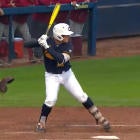On Monday, the Chicago White Sox drafted a player with the No. 3 pick, who, in our opinion, is possibly the most interesting hitter in the class: University of California, Berkley first baseman Andrew Vaughn. What makes Vaughn so interesting? He pits baseball convention against itself.
Typically, the bat is the most important tool for any prospect. There are exceptions -- an outstanding defender at shortstop or catcher will be graded on a curve -- but there's usually a minimum expectation of offense for any player who has a realistic shot at playing in the majors. Vaughn has that. He might well be the best hitter in the draft. Last season, he recorded more home runs than strikeouts.
Vaughn didn't pull that trick again this year, yet one scout told CBS Sports there's a good chance he's batting top-four in the majors in the near future thanks to his polish and innate ability. He marries an excellent approach at the plate with a preternatural feel for the barrel. He projects to have at least a plus hit tool and power potential, with the chance for him to eek a little more on either -- depending, in part, on the preference of the organization he joins. Vaughn checks all the boxes teams want to see from both a scouting perspective -- he has great makeup, having worked himself into shape after previously going undrafted -- and an analytical point of view.
The problem is what Vaughn is: A 6-foot tall collegiate first baseman who bats and throws right and required a top pick to acquire. History is not kind to many of those descriptions.
Vaughn's height and handedness are factors on defense. Teams prefer taller, left-handed first basemen who can apply quicker tags on pickoff attempts and who have greater receiving bands -- attributes that matter only at first base. To wit, just three qualified batters listed 6-foot or shorter have played at least three-quarters of their games at first base this season, per Baseball-Reference's Play Index tool: Carlos Santana, Yuli Gurriel, and Christian Walker. There are exceptions to the height rule, of course. Both Jeff Bagwell and Prince Fielder were on the shorter side, yet no one complained about having their bats in the lineup.
Height isn't the only potential blemish working against Vaughn. Consider the fates of the five collegiate first baseman have been drafted in the top-10 since 1998 (note that Mark Teixeira was drafted as a third baseman):
- Brendan McKay (4th, 2017): His future is on the mound, likely as a No. 3 starter.
- Pavin Smith (7th, 2017): Pushing his career slugging over .400 has been a challenge.
- Yonder Alonso (7th, 2008): Has been better in recent years, as he's learned to tap into his power. But has been -- at best -- a league-average player for his career.
- Matt LaPorta (7th, 2007): Washed out of professional baseball before turning 30.
- Carlos Pena (10th, 1998): Bounced around a bit before receiving MVP votes in consecutive years later in his career.
Vaughn, obviously, was taken higher than any of the others.
To make matters even worse, Vaughn is a right-handed hitter. At any given time, there's roughly three right-handed first basemen who most teams value as long-term pieces. Otherwise, they're by and large viewed as expendable pieces -- that's not the description you want when you're selecting someone third overall.
Add it all up, and you can understand the Vaughn dilemma: He's a good prospect who could make an impact as soon as anyone else in the class. But in order to do so, he'll need to be an outlier in many regards. Will the White Sox's gamble pay off? We'll see.
![[object Object] Logo](https://sportshub.cbsistatic.com/i/2020/04/22/e9ceb731-8b3f-4c60-98fe-090ab66a2997/screen-shot-2020-04-22-at-11-04-56-am.png)


















